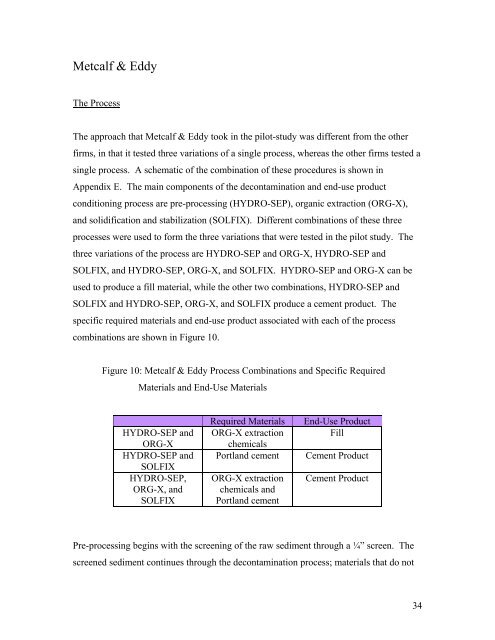New York/ New Jersey Harbor: Alternative Methods for Ex ... - CLU-IN
New York/ New Jersey Harbor: Alternative Methods for Ex ... - CLU-IN
New York/ New Jersey Harbor: Alternative Methods for Ex ... - CLU-IN
You also want an ePaper? Increase the reach of your titles
YUMPU automatically turns print PDFs into web optimized ePapers that Google loves.
Metcalf & Eddy<br />
The Process<br />
The approach that Metcalf & Eddy took in the pilot-study was different from the other<br />
firms, in that it tested three variations of a single process, whereas the other firms tested a<br />
single process. A schematic of the combination of these procedures is shown in<br />
Appendix E. The main components of the decontamination and end-use product<br />
conditioning process are pre-processing (HYDRO-SEP), organic extraction (ORG-X),<br />
and solidification and stabilization (SOLFIX). Different combinations of these three<br />
processes were used to <strong>for</strong>m the three variations that were tested in the pilot study. The<br />
three variations of the process are HYDRO-SEP and ORG-X, HYDRO-SEP and<br />
SOLFIX, and HYDRO-SEP, ORG-X, and SOLFIX. HYDRO-SEP and ORG-X can be<br />
used to produce a fill material, while the other two combinations, HYDRO-SEP and<br />
SOLFIX and HYDRO-SEP, ORG-X, and SOLFIX produce a cement product. The<br />
specific required materials and end-use product associated with each of the process<br />
combinations are shown in Figure 10.<br />
Figure 10: Metcalf & Eddy Process Combinations and Specific Required<br />
Materials and End-Use Materials<br />
HYDRO-SEP and<br />
ORG-X<br />
HYDRO-SEP and<br />
SOLFIX<br />
HYDRO-SEP,<br />
ORG-X, and<br />
SOLFIX<br />
Required Materials End-Use Product<br />
ORG-X extraction<br />
chemicals<br />
Fill<br />
Portland cement Cement Product<br />
ORG-X extraction<br />
chemicals and<br />
Portland cement<br />
Cement Product<br />
Pre-processing begins with the screening of the raw sediment through a ³“ screen. The<br />
screened sediment continues through the decontamination process; materials that do not<br />
34
















